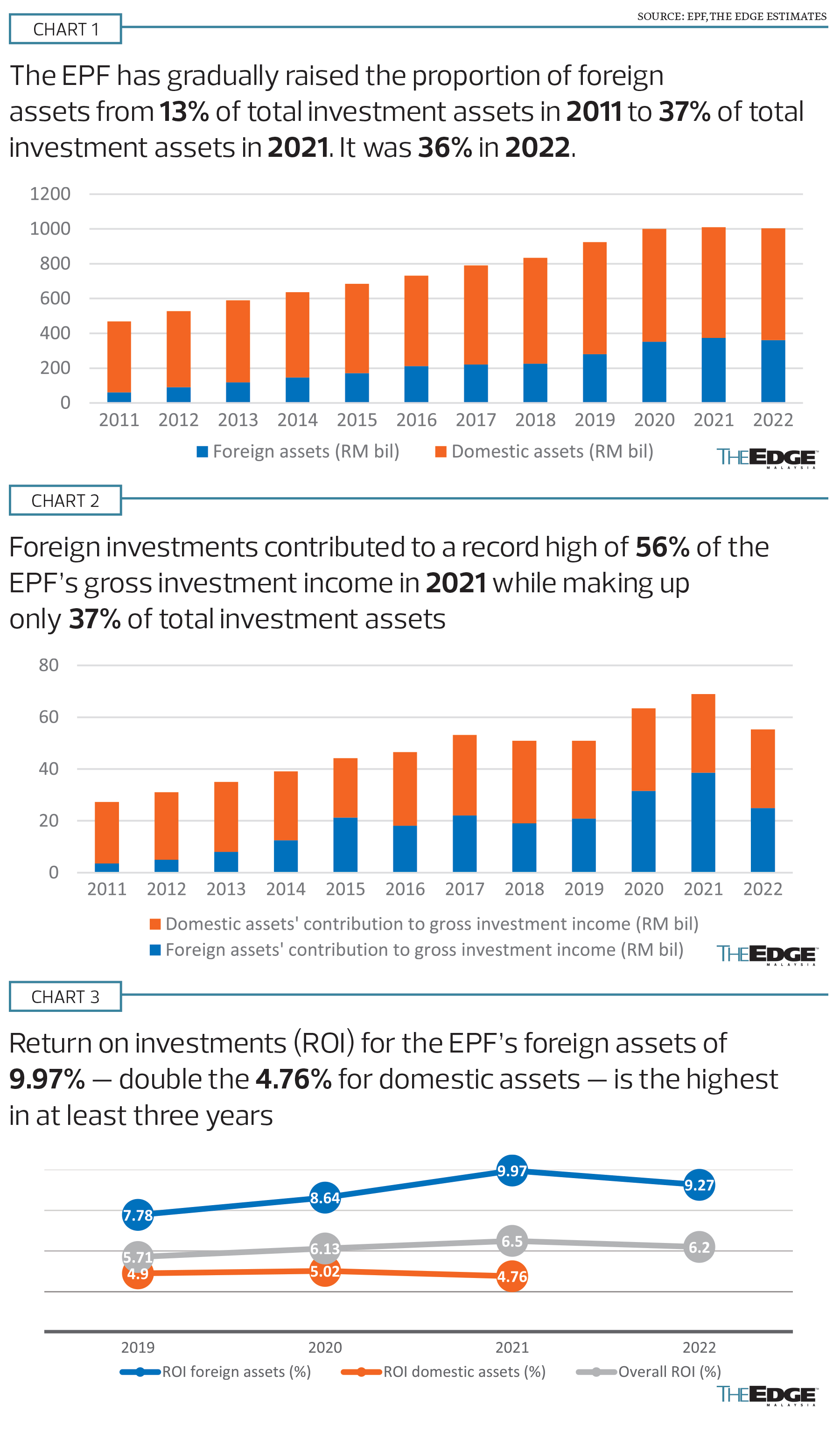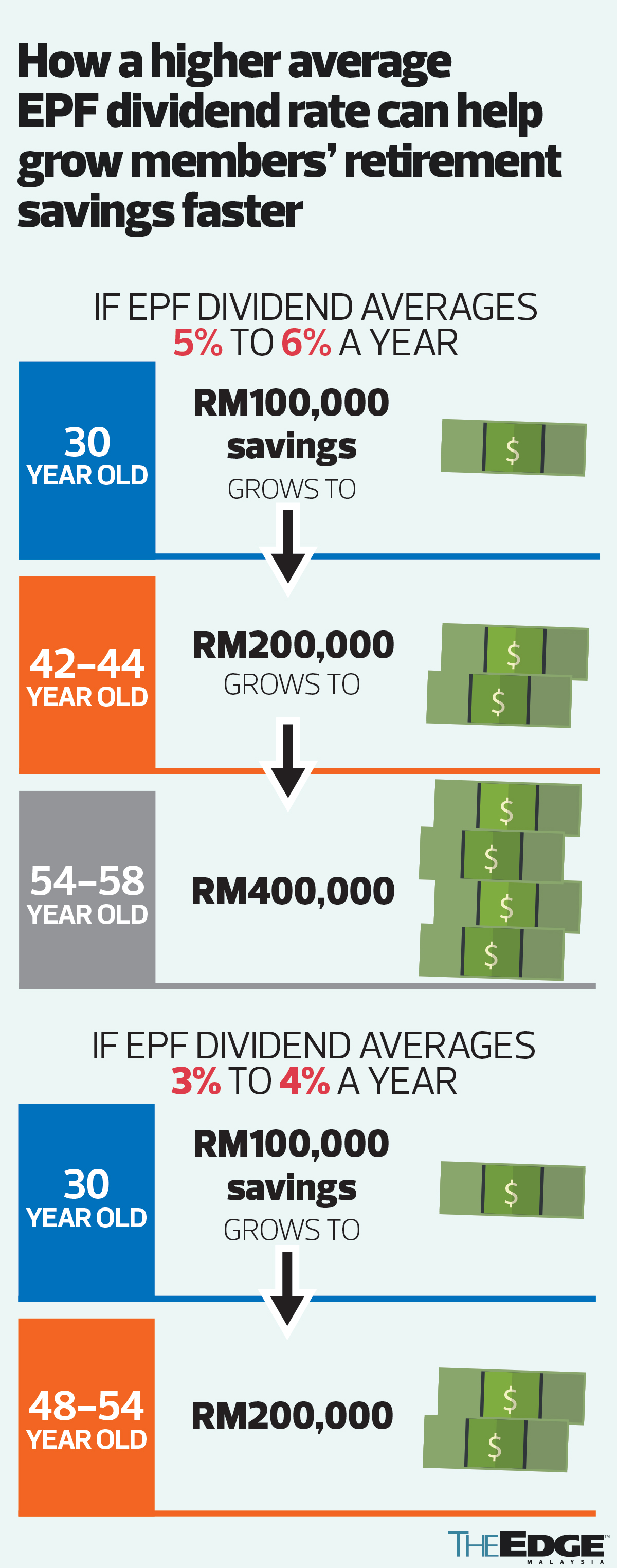
This article first appeared in The Edge Malaysia Weekly on May 1, 2023 - May 7, 2023
THE Employees Provident Fund is set to announce its first quarter performance anytime over the next three to six weeks from its new headquarters in Kwasa Damansara, Selangor. Of interest is the performance of its overseas assets, in particular foreign equities, which punch above their weight when it comes to contributions to the EPF’s investment income and, consequently, dividend payments.
Given that return on investments (ROI) from its foreign investments are significantly above that of its domestic investments, dividends from the EPF would have been much lower had the provident fund not decisively diversified more of its investment assets overseas just over a decade ago — moving from having just 13% of its portfolio outside Malaysia in 2011 to 20% in 2013 and 28% in 2017. The EPF had targeted to have at least 32% of its assets overseas since 2017, though it was only in 2019 that it managed to put more than 30% of its assets outside Malaysia. The 32% threshold was passed in 2020, with the EPF having 36% of its assets abroad in 2022, slightly lower than 37% of its total investment assets in 2021. (See Chart 1.)
The EPF, in its 2021 annual report, described overseas assets as “critical contributors to the EPF’s investment income”. That year, foreign investments contributed to a record high of 56% of the EPF’s gross investment income while making up only 37% of its total investment assets, which stood at RM1.01 trillion in 2021. (See Chart 2.)
Income netted from its overseas investments was enough to pay 3.4% to 4.1% dividends in the year the EPF announced the headline-grabbing 6.1% dividend (conventional) for 2021, our back-of-the-envelope calculation shows.
The ROI for foreign assets in 2021 was 9.97% — double the 4.76% for its domestic assets — and the highest in at least three years, possibly enhanced as the ringgit weakened versus the US dollar (see Chart 3). The ROI from foreign-listed equities alone was even higher at 10.44%, according to EPF data.
Put another way, 2021 dividends would have been nearer to 3.1% instead of 6.1% if the EPF’s entire portfolio had been invested in Malaysia, back-of-the-envelope calculation shows.
A significantly lower dividend rate would prove to be painful for EPF members’ retirement savings over the long term, given that savings would need 24 years to double if compounded at only 3% per annum compared with 12 years at 6% per annum. Savings would take just over 10 years to double at 7% per annum, just over 14 years at 5% per annum and 18 years at 4% per annum.
For the layman, a 30-year-old member who has saved up RM100,000 with the EPF would see that money double to RM200,000 by the age of 42 to 44 if EPF dividends were to average at 5% to 6% per annum over the 12-to-14-year period and thereafter have RM400,000 saved up by the time he or she is 54 to 58 years old at that same rate. If dividends were to fall to just 3% to 4%, however, that 30-year-old with RM100,000 savings would only be able to grow that to RM200,000 when he or she is between the age of 48 and 54 — making it tougher to meet the EPF’s recommended basic savings of RM240,000 by age 55. (See graphic.)
Premature harvesting
Here’s where the picture gets less rosy. When announcing the higher-than-expected 6.1% dividend for 2021 in March 2022, EPF CEO Datuk Seri Amir Hamzah Azizan told reporters that the EPF had brought back RM22 billion from its overseas investments “that had been built up over quite a number of years” — some prematurely to meet liquidity needs to satisfy Covid-19-related withdrawals. This was to avoid rattling the local market, where the EPF is already a hefty investor.
It is not immediately known if the EPF also did premature selling of foreign assets in 2020 in preparation for liquidity needs from Covid-19-related withdrawals, given that the i-Sinar withdrawals (which saw RM58.7 billion prematurely taken out from the EPF in 2021) were first proposed in November 2020 when Budget 2021 was tabled, even though criteria for withdrawals up to RM60,000 each were only lifted in February 2021.
Income from the EPF’s foreign investments was also exceptionally high in 2020, contributing nearly half of gross investment income while making up just over 35% of the EPF’s total investment assets. While dividend for 2020 was lower at 5.2% (conventional), contributions from foreign income were probably enough to pay 2.5% of dividend, back-of-the-envelope calculation shows. At 8.64% in 2020, the ROI for foreign investments was also significantly above the 5.02% ROI achieved for domestic investments that year that brought overall ROI to 6.5%.
ROI for foreign investments remained high at 9.27% in 2022 (above 6.2% of overall ROI) when the EPF’s foreign investments contributed 45% (56% in 2021) to gross investment income even as its proportion to total assets eased to 36% (from 37% in 2021).
Some may ask if the EPF’s dividends would have been lower in 2021 if it had not prematurely divested some of its overseas assets to satisfy its liquidity needs. Yet arguing the case for more premature selling of overseas assets can be likened to immediate gratification from forcing eggs out from a golden goose at the consequence of it not being able to lay those coveted golden eggs thereafter. As the EPF needs to generate decent dividends year after year over the long haul, rather than just high dividends for just one or two years, it is important to allow the fund to invest for future harvests.
The impact of the lack of higher returns from foreign income can, for instance, be seen in the lower dividends paid for shariah savings (4.75% dividend in 2022) compared with conventional savings (5.35% dividend in 2022).
In explaining the difference in returns at its conventional versus shariah portfolio in 2022, the EPF had said the higher ROI for its conventional assets was due to “higher allocation in foreign equities and private markets”. The EPF had allocated 43.6% in foreign assets for the conventional portfolio versus only 24.1% in foreign assets for its shariah portfolio — the bulk of it being in equities (foreign equities make up 24% of the conventional portfolio versus 19.1% of the shariah portfolio while the private equity allocation was 6.9% for the conventional portfolio versus 0.5% for shariah).
The EPF had previously succinctly explained why the fund needs to diversify overseas to over 40 countries and 28 currencies. “Markets by their very nature are cyclical. There are good and bad times, and our performance as a well-managed long-term retirement fund should be measured not merely by how we preserve members’ savings, but also how well we enhance them,” the EPF said in its 2018 annual report, relating to why the gradual increase in its foreign investments not only reduces concentration risks in the domestic market but also gives it the flexibility to rebalance between different markets and asset classes at different times.
The fund should be allowed to continue growing members’ retirement savings abroad, as guided by its strategic asset allocation, which naturally allocates most of its assets to Malaysia as its obligations to members are in ringgit.
Save by subscribing to us for your print and/or digital copy.
P/S: The Edge is also available on Apple's App Store and Android's Google Play.
- SumiSaujana slumps on ACE Market, on course to be worst IPO debut
- Asian stocks tumble again as US hits China with 104% tariffs, Treasuries slammed
- Malaysian palm oil producers could capture US market share from Indonesia with better pricing — CGS International
- Malaysian stocks broadly lower as Trump’s reciprocal tariffs come into force
- Lawyer launches constitutional challenge against Judicial Appointments Commission's judge appointment power
- UK borrowing costs hit highest since 1998 amid global bond rout
- China says it does not want trade war but will fight US tariff hikes
- Witness protection unit DG challenges order to testify in 1MDB-Tanore trial
- 1MDB withdraws suit against Singaporean Shabnam in US$346m Rosmah luxury goods case
- WTEC Group braves global market rout, launches ACE Market IPO to raise up to RM33m


